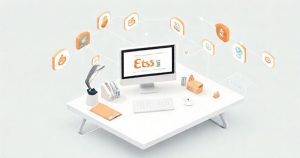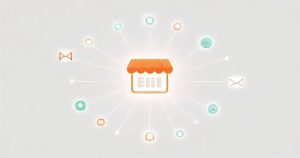Etsy integrations are powerful third-party applications that connect directly to your shop, automating tasks and unlocking new capabilities. For sellers aiming to scale their business, these tools are not just a luxury but a necessity. They handle everything from print-on-demand fulfillment to social media marketing and accounting, freeing up your valuable time to focus on creating new products and engaging with customers. By leveraging the right integrations, you can transform your solo operation into a streamlined, efficient, and more profitable business.
What Are Etsy Integrations And Why Do They Matter?
An Etsy integration is a software bridge that allows another application to securely access your shop’s data. This connection enables seamless automation. For instance, when a customer places an order for a t-shirt, a print-on-demand integration can automatically receive the order details, print the design, and ship it directly to the customer without you ever touching the product. This creates a passive income stream and eliminates the need for holding physical inventory.
The primary benefit of using Etsy integrations is efficiency. Repetitive tasks that consume hours each week, such as updating inventory, creating shipping labels, or posting on social media, can be done automatically. This reduces the risk of human error and allows you to manage a much larger volume of orders. For sellers who feel overwhelmed by the administrative side of their business, integrations are the key to sustainable growth and avoiding burnout.
Key Integration Categories For Etsy Sellers
Choosing the right tools depends on your business model and biggest challenges. Most integrations fall into a few key categories, each designed to solve a specific problem for Etsy sellers. Understanding these categories will help you identify which solutions will have the most significant impact on your shop’s performance and your personal workload. Focus on addressing your most pressing needs first before expanding your toolkit.
Print on Demand (POD) Integrations
Print on Demand is one of the most popular business models on Etsy, and it relies entirely on seamless integrations. Services like Printful and Printify connect to your shop, allowing you to list virtual products like t-shirts, mugs, and posters. When a sale is made, the POD provider handles production and shipping. You only pay for the product after you have made a sale, eliminating upfront inventory costs and risks. This model offers incredible scalability for artists and designers.
When selecting a POD partner, consider their product catalog, print quality, fulfillment times, and shipping costs. Printful, for example, is known for its high-quality printing and branding options, while Printify offers a wider network of print providers, which can lead to more competitive pricing. Both offer a direct and reliable connection to your Etsy dashboard, making product creation and order management incredibly simple.
Shipping and Fulfillment Integrations
For sellers who manage their own inventory, shipping is often the biggest bottleneck. Shipping integrations like Pirate Ship or ShipStation import your Etsy orders automatically, allowing you to buy and print shipping labels in bulk at discounted rates. This saves a tremendous amount of time compared to manually entering addresses for each order. They also automatically mark orders as shipped on Etsy and send tracking information to your customers.
These platforms provide a centralized dashboard for all your shipping needs, simplifying logistics and reducing costs. By comparing carrier rates and creating fulfillment workflows, you can ensure a professional and timely delivery experience for your buyers. This not only improves your efficiency but also boosts customer satisfaction and increases the likelihood of positive reviews, which are vital for your shop’s reputation and visibility in search results.
Marketing and Social Media Automation
Promoting your products is essential for driving traffic and sales, but it can be a full-time job. Marketing integrations help automate this process. Tools like Outfy or Vela can automatically create and schedule social media posts for your new listings, share positive reviews, or run promotional campaigns across platforms like Instagram, Pinterest, and Facebook. This ensures your shop maintains an active and consistent online presence, even when you are busy.
Vela also offers powerful bulk-editing features, allowing you to update hundreds of listings at once. You can change prices, renew listings, or optimize tags and titles in a fraction of the time it would take to do manually on Etsy. These marketing tools are designed to help you reach a wider audience and drive more targeted traffic back to your shop with minimal daily effort.
Accounting and Bookkeeping Integrations
Managing finances is a critical but often overlooked aspect of running an Etsy shop. Accounting integrations like QuickBooks Self-Employed or GoDaddy Bookkeeping connect directly to your Etsy account to import sales and fee data automatically. This eliminates the need for manual data entry and provides a clear, real-time overview of your revenue, expenses, and profitability. These tools are indispensable during tax season.
By categorizing your expenses and tracking your financial health, you can make smarter business decisions. You can easily see which products are most profitable, understand your true profit margins after fees, and forecast future earnings. Proper bookkeeping provides the financial clarity needed to grow your shop from a hobby into a serious, sustainable business enterprise.
Etsy Integrations Vs. Standalone Software
When exploring tools to help your business, it is important to understand the difference between a direct integration and standalone software. An integration offers a two-way sync with your Etsy shop, automating data transfer and actions. For example, a shipping integration pulls order data and pushes back tracking numbers. This seamless workflow is the primary advantage of integrated applications and saves the most time.
Standalone software, on the other hand, does not connect directly to your shop. SEO tools like eRank or Marmalead are excellent examples. While they do not integrate to automate tasks, they provide invaluable data and analysis to help you make strategic decisions about keywords, trends, and competition. Many successful sellers use a combination of both: integrated apps for automation and standalone tools for research and strategy, creating a comprehensive system for shop management.
Unlocking Your Shop’s Full Potential Through Smart Automation
Ultimately, Etsy integrations are strategic assets that empower you to work smarter, not harder. By automating the repetitive and time-consuming aspects of running an online business, you can reclaim your focus for what truly matters: creativity, product development, and customer service. Start by identifying your biggest pain point—whether it is shipping, marketing, or inventory—and find an integration that solves it. This strategic adoption of technology is the path to scaling your Etsy shop beyond your personal limits.






